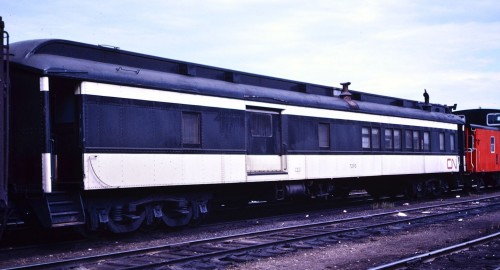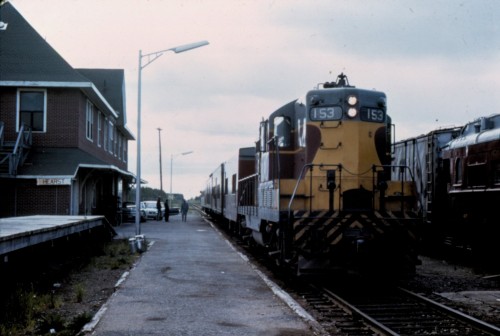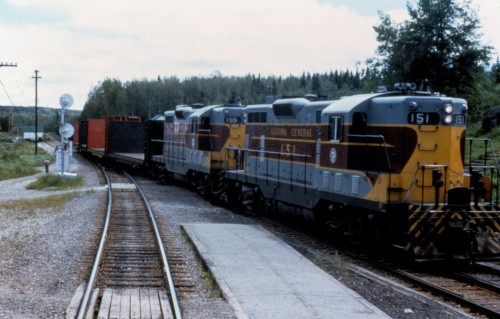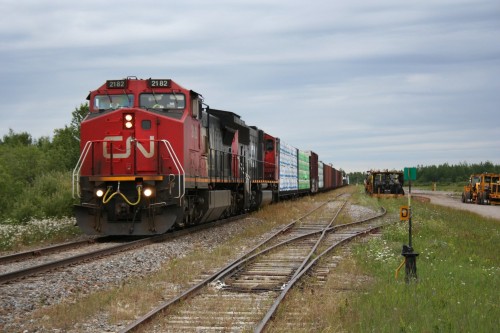Hearst was the Algoma Central’s northern terminus and connection to the Canadian National Railway. For yard, station and other facilities the ACR shared with CN.
The ACR wye and connection to the CN main was just to the west of Hearst yard, and any movements on the CN main from Hearst Junction to Hearst would have to be made under the CN dispatcher’s authority. Conversely, if CN needed to turn some equipment, movements over the wye required the ACR dispatcher’s authority.
Equipment Restrictions
When the ACR first connected to Hearst in 1914, Hearst was a division point on the transcontinental mainline of the National Transcontinental Railway. However when the NTR became part of the Canadian National Railways in the early 1920s, this became a secondary line to the ex Canadian Northern Railway main line (crossed by the ACR at Oba) which is still CN’s primary transcontinental route today. As such, this line languished and was never maintained to the same standard as a more major route.
The Pagwa subdivision between Hearst and Nakina featured exceptionally light rail – often less than 80 lbs/yard – that had never been upgraded since the steam era and probably in these late years a fair bit of deferred maintenance in general. This line was *severely* restricted as to the weight and types of equipment that could run over it, with the heaviest diesel locomotive permitted on the line being an SW1200RS. (CN 1387-1395 are known to be in Hearst in the late 1970s.) Cars with greater than 177,000 lbs (88 tons) *gross* weight required special handling, and during the months of May-June for the spring thaw cars exceeding 142,000 lbs (71 tons) gross weight are banned west of Calstock.
East of Hearst is better, but still light rail. GP9s could operate west of Kapuskasing to Hearst, but between these two stations heavy six axle units like C630s and SD40s were explicitly banned and even modern four axle road switchers such as C424s, GP38-2s and GP40-2s are to be used “only in emergency, and at 10 miles per hour below” the regular speed limit making a GP9 pretty much the biggest unit that could be expected to run into Hearst in the 1970s and 1980s.
The north end of the ACR was also relatively light rail (but definitely better maintained than between Calstock and Nakina, which CN was trying to abandon anyway) and AC trains typically avoided using their six axle SD40 units north of Hawk Junction.
Passenger Service
Passenger service west of Hearst to Nakina (junction with CN’s main line) was actually still provided during the early 1980s by trains 272/273. While officially listed as mixed (freight and passenger) trains in the timetable, most sources seem to agree that in practice it was passenger-only in the 1980s, with any westbound freight routed via the ACR to Oba, as there was zero on-line freight traffic except for the Lecours lumber mill at Calstock, which by this point would be served by a turn job out of Hearst yard. CN was petitioning to abandon the line between Calstock and Nakina at this point, and moving the through traffic off of the line probably helped to destroy any remaining on-paper revenue and support their petition. And due to the extreme weight restrictions on the line, a lot of traffic simply could not go that way. Abandonment formally happened in 1986 and the line was torn out west of Calstock.
The (non) “mixed” typically ran with an SW1200RS and single heavyweight baggage/coach combination car. CN 7210 appears to have been the regularly assigned car on this line. This car remained in CN colours all through the early 1980s, although passenger service was officially operated by VIA Rail then. In my summer 1979 CN timetable, 273 departs Hearst at noon on Tuesdays, Thursdays and Saturdays, with 272 from Nakina running on opposite days (Wednesdays, Fridays, Sundays) and scheduled to arrive at 5:30 pm.
There was no passenger service running east out of Hearst anymore by this point in time. Hearst was once the final destination of local passenger service from Cochrane, connecting with southbound trains over the Ontario Northland to Toronto, but by the late 1970s passenger service was provided only as far as Kapuskasing by the joint CN-ONR train the “Northland” from Toronto. (Replaced later by the Toronto-Cochrane coach-only “Northlander”, which itself was discontinued in 2009.)
The Algoma Central’s passenger service ran daily except Monday from Sault Ste. Marie to Hearst during the spring/summer, and on the weekends only (Fridays through Sundays) during the fall/winter season. No. 1 had a scheduled arrival time of about quarter after seven during the summer, and quarter to six in the winter. The ACR train would tie down on the main track in front of the station and depart early the next morning as no. 2. (On days that the CN “mixed” ran, the inbound ACR would arrive up to two hours after, and the outbound train would be almost to Hawk Junction by the time of the 273’s noon departure.)
Freight
Local switching of the yard and local industries around Hearst would have been performed by CN, as it was their track and facilities. The lumber mill at Calstock would have also been handled by an extra turn job out of Hearst yard although I do not know when this would run.
The 1979 CN timetable shows a Kapuskasing subdivision freight departing Hearst at 11 am on Tuesdays, Thursdays and Saturdays for Cochrane. I would presume that the CN crew would spend the morning performing the local switching requirements
The corresponding westbound is not timetabled, but I would assume it to operate as an extra on opposite days (Wednesdays, Fridays, Sundays) the same as the mixed train to the west of Hearst.
My 1989 CN timetable does not have any freight schedules actually listed for the Kap. sub, and sadly I do not have one from closer to 1985.
As mentioned above, except for the lumber mill at Calstock, there was no on-line freight customers on the Pagwa subdivision towards Nakina, and due to the condition of the line, really no traffic at all was actually routed over this line anymore at this point, instead being handled by the ACR to Oba to be returned to CN for the trip westward.

ONT no. 516 prepares to depart Hearst for Kapuskasing with several loads of lumber from Lecours and several loads of copper concentrate from Michigan bound for Rouyn-Noranda. July 2015, my photo.
The Kapuskasing subdivision and the remains of the Pagwa subdivision to Calstock (the rest abandoned in 1986) were sold to Ontario Northland in August 1993.
On the ACR side of things, ACR freight no. 5 would arrive in Hearst in the evenings on weekdays, Monday through Friday, with no. 6 departing south with interchange traffic the following day, Tuesdays through Saturdays.




